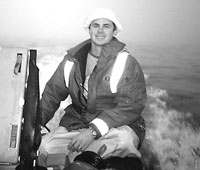|
HOME SEARCH ARCHIVE |
|
Seabird researchers rescue
boaters from cold waters near Santa Cruz
By Jill Goetz, College
of Natural Resources
| |
 Benjamin Becker. Nathan Jones photo. |
On August 7, Becker, of the Department of Environmental Science, Policy and Management in the College of Natural Resources, rescued five people after their 31-foot charter fishing boat hit a submerged object off the coast of Davenport, about 15 miles north of Santa Cruz, and sank. The group spent up to 30 minutes in 52 degree-Fahrenheit waters of Aņo Nuevo Bay before being rescued by Becker and Nathan Jones, a field assistant from UC Santa Cruz, with onshore assistance from John Benson of Humboldt State University.
The three researchers had been participating in a study of the Marbled Murrelet, an 8-inch-long seabird that nests in old-growth forests along the coastline and is listed as threatened under the federal Endangered Species Act and endangered on California's state list.
After four hours on the water, the students had returned the UC-owned Zodiac inflatable research vessel to shore at approximately 10:30 a.m. About the same time, Frank "Lud" McCrary heard shouts of "Mayday! Mayday!" on the Coast Guard marine radio frequency in his office. McCrary is co-president of Big Creek Lumber Co., whose offices are located on the east side of Highway 1 overlooking this remote stretch of coast. He has long monitored this area for the Coast Guard.
Through a telescope, McCrary spotted five people about a mile offshore, vainly attempting to bail water from their fast-sinking boat. Within minutes he saw them don life preservers and jump into the water, none wearing a wetsuit. Just then he saw the researchers drive by, towing the Zodiac. McCrary's brother, Bud, caught up with the researchers, who raced back to the water, with Becker and Jones re-boarding the craft and Benson assisting from on shore. Though the Coast Guard and others were called, the students reached the stranded boaters well before anyone else arrived.
Shipwreck survivor Jolene Bunnell, a physical education teacher from San Jose, recalled hearing a loud noise and immediately feeling the fishing boat sink beneath her feet. "We were scared," she said. "There were no other boats anywhere, and we were all thinking of sharks."
She, along with the three other passengers and captain of the ill-fated craft spent up to 30 minutes in the water before the Zodiac arrived. Once back to shore, the waterlogged survivors received both medical and media attention. None required hospitalization. Several have since contacted their rescuers to thank them for - they firmly believe - saving their lives; the Santa Cruz Port District will formally thank the researchers in late September with the Harbor Good Citizen Award.
The experience left Becker unfazed; he was back on the Zodiac the next day.
Under the direction of associate professor Steven Beissinger, he and doctoral student Zach Peery are gathering data on the Marbled Murrelets' feeding, reproductive and nesting habits at sea, using sophisticated radio telemetry and global position systems technology as well as the naked eye. Their research project, one of the first attempts to follow individual murrelets at sea, may help wildlife managers and policy makers increase the birds' numbers.
While most seabirds nest in the sand or offshore on rocky islands and cliffs, the Marbled Murrelet flies inland up to 50 miles to nest in the uppermost limbs of old-growth coniferous trees, mostly Redwoods - at heights of up to 200 feet. Perhaps not surprisingly, it was the last bird in North America to have its nest discovered.
Scientists estimate
there are no more than 3,000 Marbled Murrelets left in California. The
researchers are studying the state's smallest population, numbering approximately
1,000, in Año Nuevo Bay at the birds' southernmost breeding range.
A population projection model developed by Beissinger suggests this population
may be declining up to 10 percent a year. Destruction of old-growth trees
is believed the main cause, although oil spills, gill-net fishing and
El Niño are also to blame. Much
UC marine research is conducted by the Santa Cruz and San Diego campuses;
the Zodiac used for the Murrelet studies is one of two Cal-operated research
boats used off the California coast, said Deborah Penry, assistant professor
of integrative biology and a member of Becker's dissertation committee.
"Ben's research efforts are made even more remarkable by the fact that
Cal researchers do not generally have ready access to local coastal waters
as do researchers at some of our sister institutions," she said.
[HOME] [SEARCH] [ARCHIVE] [ABOUT] [CONTACT] [MORE NEWS]
Copyright 2000, The Regents of the University of California.
Produced and maintained by the Office of Public Affairs at UC Berkeley.
Comments? E-mail berkeleyan@pa.urel.berkeley.edu.